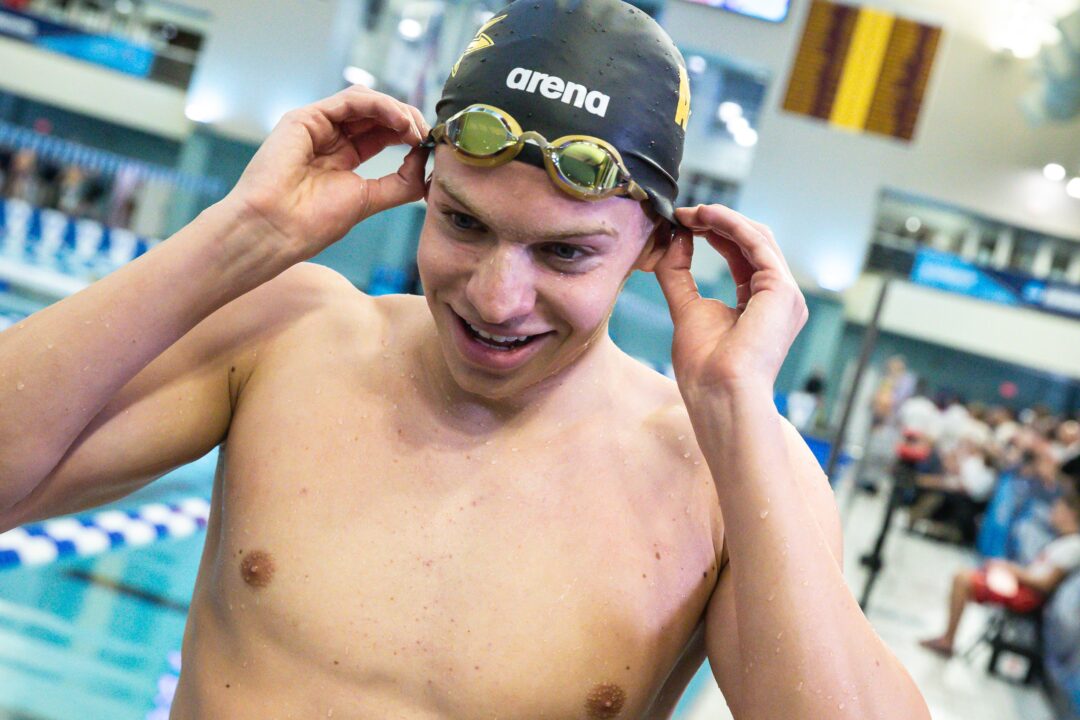The NCAA has formed an exploratory committee to examine the possibility of changing the American collegiate swimming system from imperial yards memberships to the more globally-accepted metric system standard.
Multiple NCAA coaches confirmed the news to SwimSwam, with the committee expected to report its conclusions at an upcoming national coaches meeting.
“We really feel that swimming & diving can be a global product that builds the NCAA brand around the world,” said Brandon French, the NCAA’s sport administrator for swimming & diving. “Incoming NCAA President Charlie Baker firmly believes in the global potential of the NCAA, and this will prove as an important canary in the coal mine for the future of collegiate athletics.”
Sources tell SwimSwam that the committee, which includes coaches, athletics directors, and facility managers, will examine the potential of moving to either a 25-meter course or 50-meter course as the primary standard for NCAA competition. Presently, the NCAA approves 25-yard and 25-meter pools as official competition, and provides a conversion standard from 25-meter to 25-yard times.
The NCAA Championships have been hosted in meters multiple times in the past, including 2000 and 2004 (short course meters) and 1956, which awarded a championship in 1500 long course meter freestyle (won by George Breen of SUNY Cortland). These meets have all been held in Olympic years and are viewed as a better preparation for athletes who go on to compete in the Olympic Games.
While many smaller colleges don’t have access to 25 or 50 meter pools, most Power 5 schools have pools are capable of these courses.
“Initial research shows that 68% of NCAA Division I institutions have access to 25-meter and/or 50-meter courses,” French said via email. “Realistically, those institutions without access to such pools have been three-times as likely to eliminate their swimming & diving programs over the last decade, so we expect the percentage of programs with access to long course pools to grow in coming years.”
One D1 coach SwimSwam spoke to, Dave Rollins of Florida Gulf Coast, said he likes the move. While he is not a member of the exploratory committee, he says he was involved in early discussions about the possible change.
“We want to make international swimmers feel more-welcome in the NCAA,” Rollins said. “Look at the men’s meet. Like half the races were won by international swimmers. We feel like they really contribute a lot to the system, and we want the NCAA to be the go-to place for training the world’s best swimmers.”
6 out of 13 individual swimming events at the men’s NCAA Championship meet were won by non-Americans, and 4 of 5 winning relays had at least one international leg, with the exception being the Texas men’s 800 free relay.
“I think that finish (at men’s NCAAs) is what really inspired us that now was the time to make a change,” Rollins continued.
But not all coaches around the world love the idea. Leading French coach Gileberte Fabre also applauded the move from abroad, pointing to the success of NCAA swimmers going on to win Olympic gold medals.
“10 Olympic gold medals were won in Tokyo individually by swimmers who have trained in the American college or high school systems, where the racing is done (primarily) in yards,” Fabre said. “France was at its best when many of its top swimmers were training in the United States in yards. Now we are again on top of the swimming world with Leon (Marchand) training in yards. It is a simple math.”
Marchand won three individual events and shattered the yards records in those races at the most recent NCAA Championship meet.
SwimSwam reached out to Swimming Australia for comment, but the spokesperson declined to offer much of an opinion, saying simply that “we don’t care about NCAA swimming.”
The National Swimming Pool Alliance has produced a whitepaper on the change, estimating that it could drive between $1 billion and $3 billion in new swimming pool construction over the next 5 years. “The NSPA believes that this kind of stimulus, injected into the sport of swimming, could save dozens of programs from elimination.”
French emphasized that he thought this would also help to further-simplify collegiate swimming & diving, as well as improve international performance. “NCAA track & field moved to the metric system in 1976, and the US is now the world’s leading nation in that sport. We want the same for swimming.
“In addition, we already measure diving events using meters (1-meter, 3-meter, etc.), and we really feel like this will make it easier for fans to keep track of what’s happening, if the two parts of the sport are more consistent.”
French says that he doesn’t anticipate a change, if any, happening before the 2024-2025 season.

Its a good thing this was an April Fool’s joke! Because if it was true, I’m pretty sure our AD would say to hell with it, and just end our program. No way in hell will we ever get a new pool in meters built when our current 8 lane 25yd pool is just 10 years old.
April fools
I wish the switch to meters was true. Too bad it’s a April fools joke. Switching to meters makes sense, especially on the international level. It’s only 7 feet more per length….
I fell for it because when I read it, it was the next day here and no longer April Fool’s Day!
Loved the Swimming Aus comment!
Well done SwimSwam!
I think this is the first time in 5-6 years I fell for it before I scrolled to the comments. Well done!
I could tell it was fake when the Australian quote wasn’t snobby enough
Not enough common sense in the states to actually do this
idk how yall fell for the joke, but in all seriousness ncaa should consider this
The national swimming pool alliance is pretty good